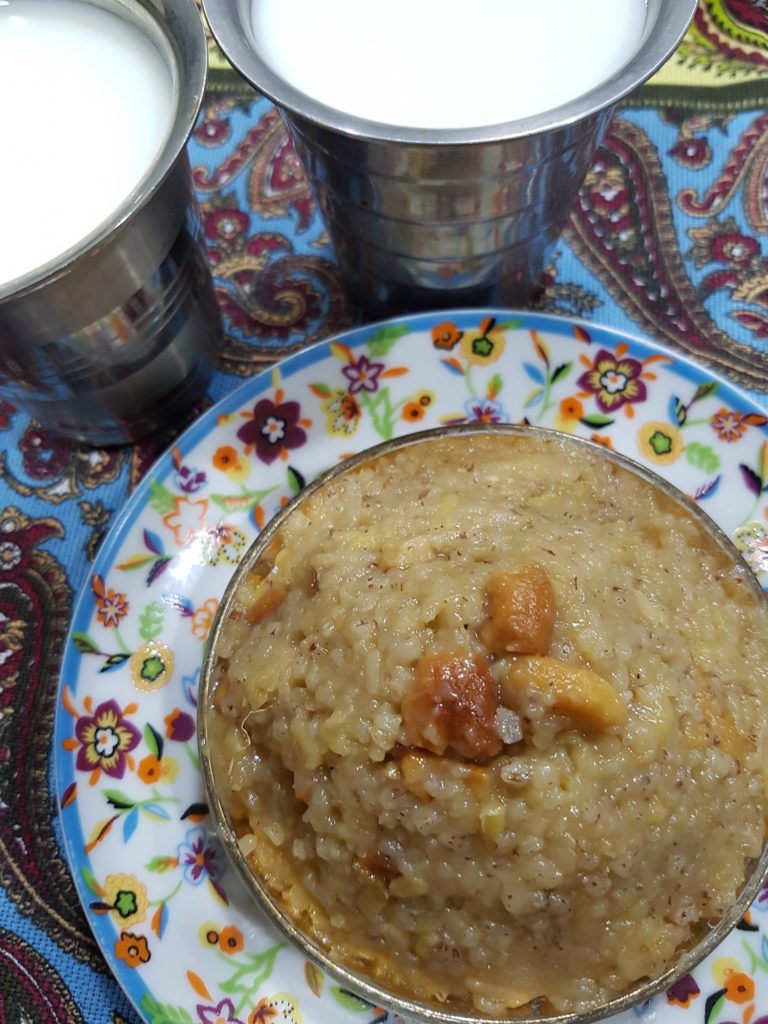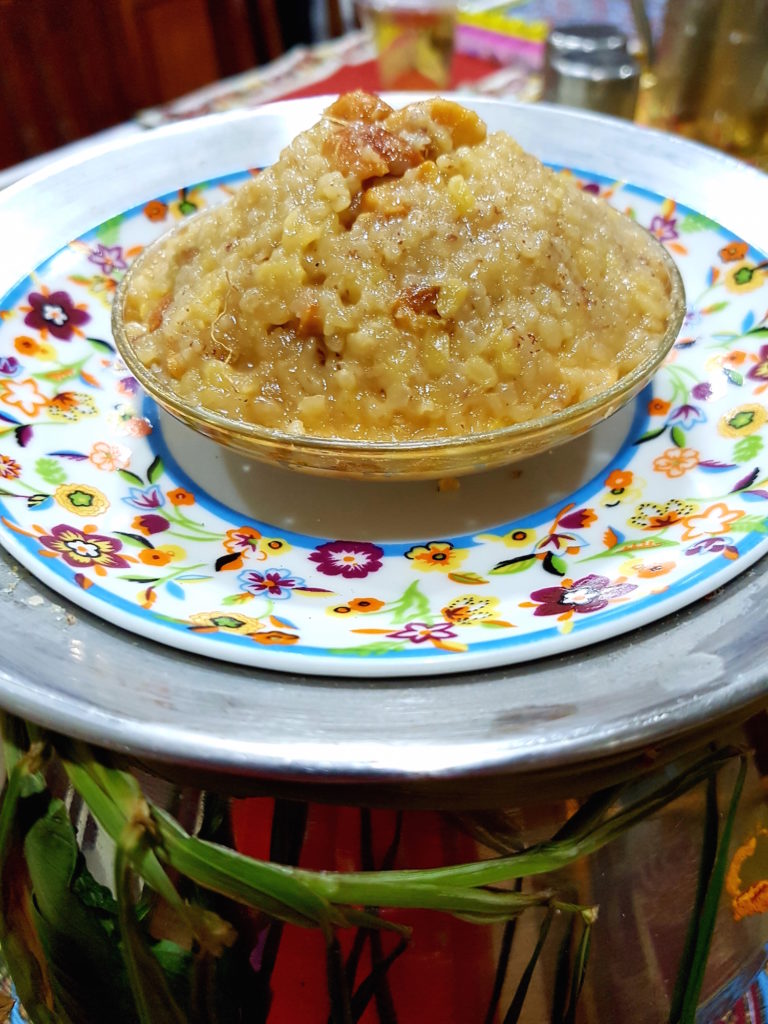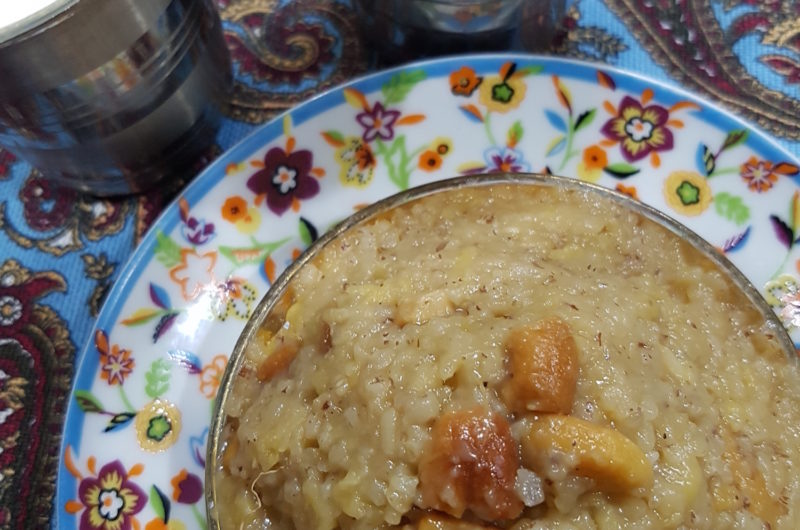
Pongal is a festive occasion for Hindus around the world. It is celebrated to thank the Sun and the Earth for the harvests of rice and other food. In villages, Pongal is celebrated very grandly. It is a 4 day celebration and each day, different foods will be cooked and shared amongst all.
In Singapore, we celebrate Pongal, keeping the traditions very much alive. We may not have the village atmosphere but we are lucky to witness Pongal Celebrations in Little India as well as in the community clubs with outdoor pongal cooking and having some cows with her calves.
Every year, I would like to cook Pongal in a different way because I am one person who can never follow a recipe to a T!.
What is Pongal? It means to overflow. We cook till the milk overflows from the pot. Some will even check the direction of the overflow, whether it is east, west, north or south?
it is a tradition to decorate our pots with turmeric, kum kum and to tie with ginger and turmeric plants around the neck of the pots. Both sweet and savoury pongal will be served today.
Of course you can use any pot but traditionally, one would use either a bronze, silver or a clay pot .

Most people know how to cook this sweet pongal rice. It is simple with easily available ingredients and it is served in all temples almost daily.
My recipe this year was so awesome and that’s why I am putting it in my blog. I would like my followers and readers to cook this recipe.
I added 2 unimaginable extra ingredients and maybe that made the difference, I felt.
Do give it a try and I am going to use this recipe from now on. Definitely a keeper, and cannot get better than this, I would say.
SARKARAI PONGAL
30
minutesIngredients
1 cup raw rice
1 cup mung beans dhal
1/2 cup ghee
1 cup milk
2 cups jaggery
1/2 cup cashew nuts
1/2 cup raisins
1/2 tsp nutmeg
1 tsp green cardamom powder
2 stalks bermuda grass (arugam pul)
1/2 tsp salt
Directions
- Rinse raw rice. Drain but keep 1 cup of rinsed water.
- Dry roast mung beans till fragrant but not too browned. Remove and add to rinsed rice and wash/ rinse both together. Drain and keep aside.
- In a pongal pot, add the 1 cup of milk and the 1 cup of rinsed rice water.
- Put the bermuda grass in the pot. Let it boil and overflow. When it overflows, remove the bermuda grass and discard. The bermuda grass will rise and float to the top to make it easy for you to discard.
- Add the rinsed rice and mung beans. Add another 5 cups of water.
- Let it cook on medium flame or low flame till rice has flowered well and very soft. Must keep stirring or else may get burnt.
- In another pan, melt the jaggery with half cup of water. Drain and keep aside.
- Once you are satisfied with the texture of the rice, add the melted jaggery, cardamom powder, salt and stir well together.
- Fry the cashew nuts in ghee first, followed by the raisins till puffed but not burnt. Keep a steady low fire when doing this.
- Add the fried cashew nuts, raisins and the ghee in it to the pot of pongal.
- Add half a tsp of nutmeg powder.
- Stir through and remove from stove.
- Can serve warm or cold.
Notes
- You may reduce the jaggery to just 1 cup and add 2 tbsp of sugar, or to 1 and 1/2 cups of jaggery.
- I don’t know why adding the rinsed water makes this dish so awesome.
- Adding the bermuda grass has some properties. It is a sweet dish, the grass lends its aroma as well as aids in digestion as this dish is rich.
- Nutmeg powder is optional but adding gives a lovely fragrance to the dish. Use freshly grated nutmeg if possible.
- If you like pongal rice to be grainy, then do reduce the water.
- Keep stirring every now and then, as the rice will burn if there is no liquid in the pot.
- I felt that adding 2 extra ingredients, bermuda grass and the rinsed rice water has given a new taste which is really out of this world. It was that good and so very tasty. I ate some in the morning next day, it was so delicious as well.
- You can reduce the amount of cashew nuts or raisins and ghee to your preferred liking
